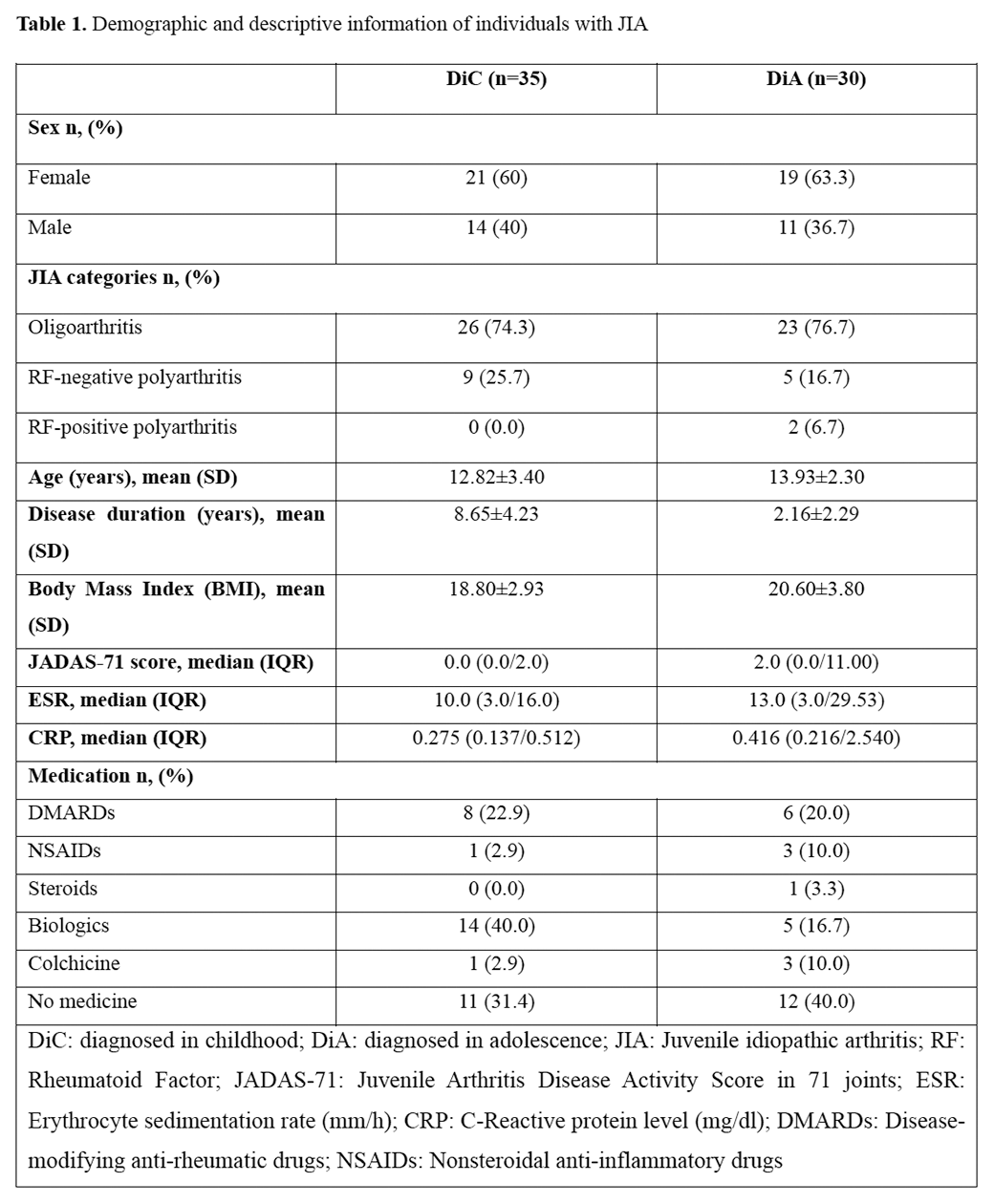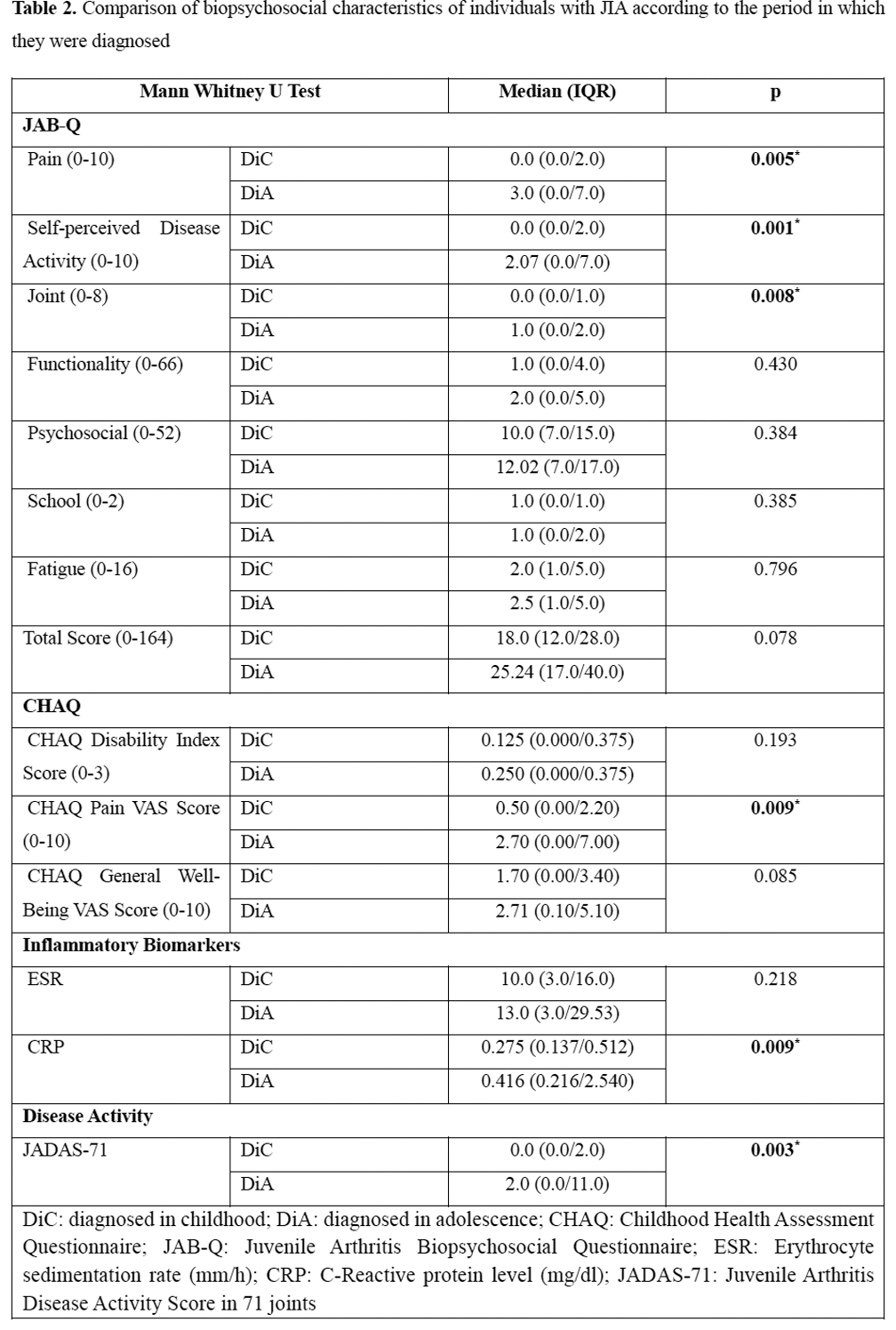

Background: Juvenile idiopathic arthritis (JIA) is defined as a chronic arthritis condition started by the International League of Associations for Rheumatology (ILAR) before the age of 16, which lasted six weeks or longer [1]. In the literature, it has been shown that individuals with JIA tend to have high pain intensity and low health as they age [2]. However, according to the diagnosis period (childhood and adolescence), it is not clear which characteristics of individuals with JIA vary.
Objectives: This study aimed to compare the biopsychosocial characteristics of individuals with JIA according to the period they were diagnosed.
Methods: Sixty-five individuals (40 girls, 25 boys) who were followed with the diagnosis of JIA between March 2022 and February 2023 were included. The individuals who received demographic information were divided into two groups: diagnosed in childhood (0-9 years) (DiC, n = 35) and diagnosed in adolescence (10-16 years) (DiA, n = 30). An expert pediatric rheumatologist recorded medical information of individuals with JIA, disease activity scores (JADAS-71), and inflammatory biomarkers (ESR, CRP). In addition, patients’ functionality (Childhood Health Assessment Questionnaire (CHAQ)) and biopsychosocial status (Juvenile Arthritis Biopsychosocial Questionnaire (JAB-Q)) were recorded. Inter-group comparisons were analyzed using the Mann-Whitney U test.
Results: There was no difference between the two groups regarding age, gender, and BMI (p> 0.05). Demographic and clinical data of individuals with JIA are shown in Table 1. Pain, disease activity, and joint scores, the sub-parameters of JAB-Q, were significantly higher in the DiA group (p<0.05). In addition, CHAQ Pain score, CRP, an inflammatory biomarker, and JADAS-71 score, which is an indicator of disease activity, were found to be significantly higher in the DiA group (p<0.05) (Table 2).
Conclusion: It is stated in the literature that older age at disease onset is associated with more severe pain levels, which confirms our findings [3]. On the other hand, it is noted that the physical, behavioral, and psychological changes that adolescence brings with it and that individuals with JIA have a high risk of experiencing mental health problems during this period [4]. For optimal outcomes in disease management, it is crucial to monitor biopsychosocial factors and other factors throughout both childhood and adolescence.
REFERENCES: [1] Petty RE, Southwood TR, Manners P, et al. International League of Associations for Rheumatology classification of juvenile idiopathic arthritis: second revision, Edmonton, 2001. J Rheumatol. 2004;31(2):390-392.
[2] Weiss PF, Beukelman T, Schanberg LE, Kimura Y, Colbert RA; CARRA Registry Investigators. Enthesitis-related arthritis is associated with higher pain intensity and poorer health status in comparison with other categories of juvenile idiopathic arthritis: the Childhood Arthritis and Rheumatology Research Alliance Registry. J Rheumatol. 2012;39(12):2341-2351.
[3] Rashid A, Cordingley L, Carrasco R, et al. Patterns of pain over time among children with juvenile idiopathic arthritis. Arch Dis Child. 2018;103(5):437-443.
[4] Hanns L, Radziszewska A, Suffield L, et al. Association of Anxiety With Pain and Disability but Not With Increased Measures of Inflammation in Adolescent Patients With Juvenile Idiopathic Arthritis. Arthritis Care Res (Hoboken). 2020;72(9):1266-1274.


Acknowledgements: NIL.
Disclosure of Interests: None declared.